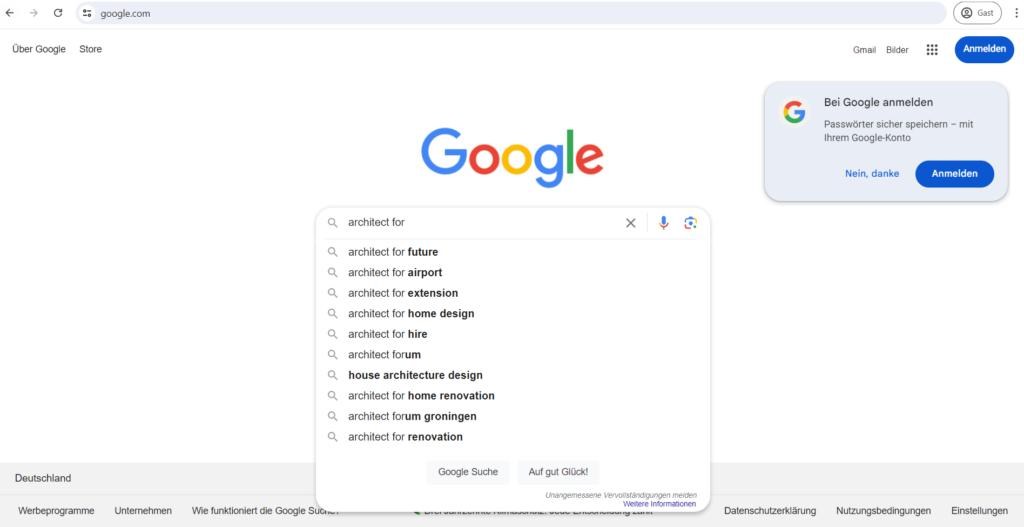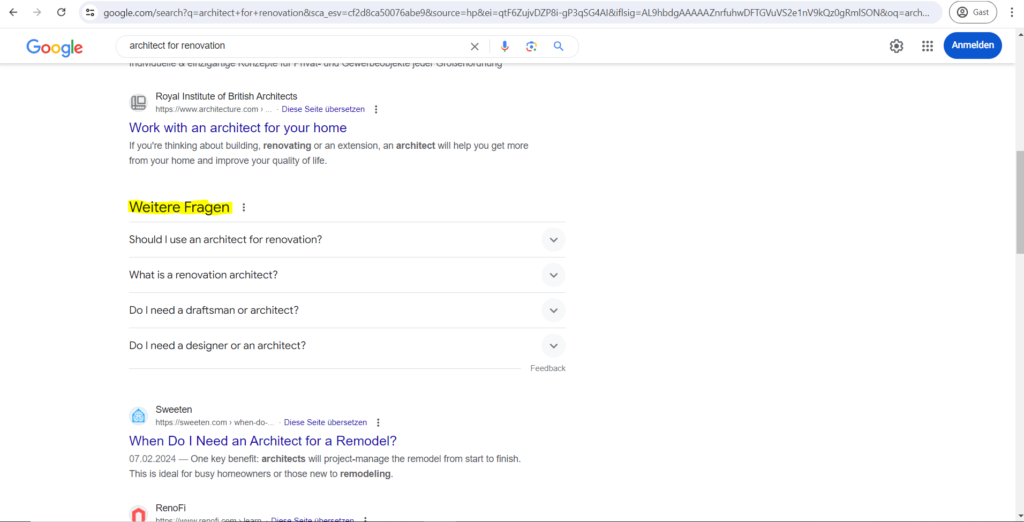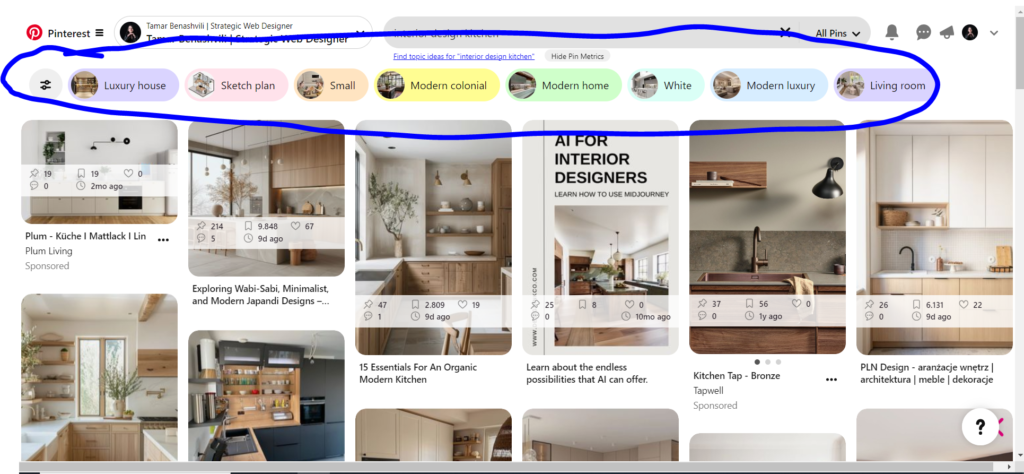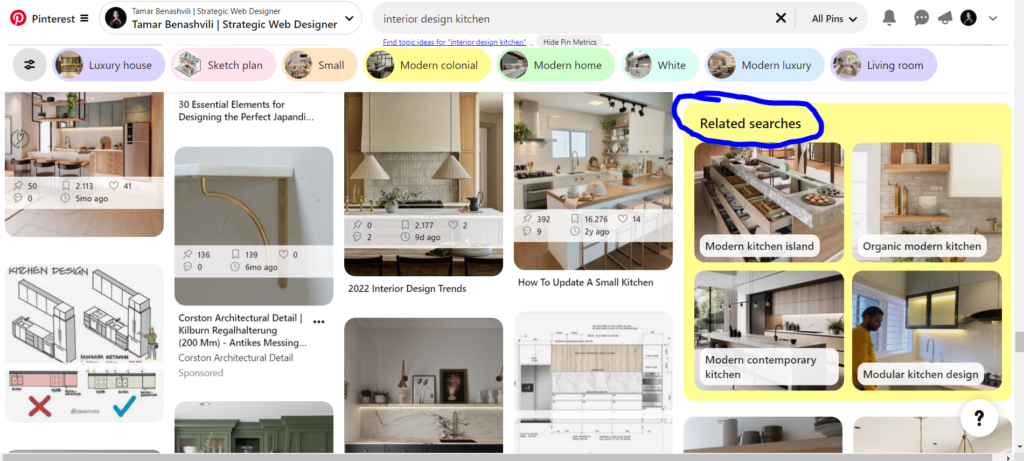SEO for architects and interior designers should be the same as for other businesses. Yet, this is not the case: most architects and interior designers refuse or forget to include the key element that makes their websites findable by the search engines: text!
Your work can speak for itself only after someone lands on your website. Of course, you can have a marketing strategy in place that promotes your work through other channels, but if you are neglecting SEO, you are rejecting a huge lead-generating potential.
The opportunity you are probably missing out on is even more significant if you consider that most architecture and interior design businesses are location-based.
Your potential clients might be typing “Architect near me”, “interior designer near me” or “house renovation architect in ….” only to find the websites of your competitors. They might not be as good a designer as you but surely they know how to be findable and generate leads.
What is SEO?
Search Engine Optimization (SEO) is a collection of strategies to increase a website’s visibility and ranking in search engine results, such as Google and Bing, when users search for related services or products. As SEO expert Neil Patel explains, “SEO is the process of taking steps to help a website or piece of content rank higher on Google.”
Essentially, the purpose of SEO is to ensure that when search engines crawl your site, they understand its content and relevance. This allows the search engine to offer the best solutions to users based on their search queries, considering factors like search terms, search intent, location, and past search history. For example, a search for “best kitchen floor material” will produce different results than “best kitchen floor material for dogs” or simply “best kitchen floor material.”
For architects and interior designers, SEO is crucial because those businesses are location-based most of the time, and targeting location search results can massively increase the number of leads for your business.
When potential clients search for specific services, such as “Prague interior designer” versus “Prague kitchen and bath designer,” the results will vary.
Who appears at the top of these search results is determined by effective SEO, which can make a significant difference in attracting the right clients to your business.
By optimizing your website with relevant keywords, quality content, and proper SEO techniques, you can ensure that your architectural or interior design services stand out in search engine results, making it easier for potential clients to find and choose you.
What are keywords & how to find them?
Keywords are the words and phrases that people type into search engines to find what they’re looking for. The first step is to create a list of keywords you want your website to rank for.
Your keywords are the terms that your Ideal Client would use to search for the services you offer. Examples include:
- Chicago architectural firms
- Residential Interior Design Miami
- Luxury home renovation NYC
Use the words and phrases your ideal clients would use and try to avoid jargon, industry-specific, or technical terms unless you’re trying to get the attention of other architects or interior designers.
The better you’re able to rank for keywords that align with your ideal clients’ searches, the more quality traffic your website will receive.
Where to find keywords
You don’t need to get expensive SEO tools to find keywords that people are actually looking for, optimize your website, and improve search rankings.
I have used both, paid and free tools and I’m here to tell you that the free tools are more than enough for your architecture or interior design business.
Google Keyword Planner
This is one of my favorite free tools. You can search for relevant keywords in a specific location and compare the search volume of different keywords to make better decisions.
Here is a quick tutorial on how to use it:
Google keyword suggestions and related searches
One of the best ways to identify the keywords your potential clients are searching for is to just go to Google and start typing. The autofill function will reveal the keywords or phrases that people are already looking for. Don’t overthink. Write down those that are most applicable to your business.
Here are screenshots. Check them out to see where to find keywords on Google.



50% of traffic to my blog comes from Pinterest. The potential of Pinterest is huge to attract more clients to your architecture or interior design business, especially if your business is not solely location-focused.
Pinterest is not a social media, it is a search engine and people come there with specific goals or problems in mind.
There are several places where you can find keywords on Pinterest.



The fourth method (which is my favorite because you can actually see the search volume) involves having a business account. Go to ads –> create –> create campaign –> manual campaign –> scroll down –> continue –> under Select a targeting strategy choose Your Own –> inserts and keywords –> keywords.
Longtail keywords
A long-tail keyword is a phrase typically consisting of three to five words. These keywords are more specific than generic phrases, allowing you to target niche demographics effectively.
According to Backlinko via HubSpot, 92% of all search queries are long-tail keywords. Because they’re more specific, long-tail keywords are less competitive than generic ones, which is advantageous for everyone. By creating content that incorporates long-tail keywords, you have a better chance of ranking well in search results for those terms.
This strategy will attract high-quality traffic to your website, which is more likely to lead to conversions. (A conversion occurs when a visitor to your website completes a desired goal, such as booking a discovery call, joining your newsletter, or making a purchase.)
For example, a search for “New Orleans luxury home architect” is a long-tail keyword, while a search for “architect” is generic. The former is significantly easier to rank for than the latter.
When creating your content, aim for a handful of long-tail keywords relevant to your business. Examples might include:
- Sustainable architecture in Austin
- Contemporary Interior Design San Francisco
- Custom kitchen remodel Los Angeles
By focusing on these specific phrases, you can better attract and convert your ideal clients.
Actionable SEO tips for architects and interior designers
Once you identify keywords or keyphrases it’s time to implement SEO strategies to rank for those keywords. Here is how:
Clear homepage headline
Ensure your homepage and service pages have clear, descriptive headlines that communicate your specialties. For instance, “Expert Kitchen and Bath Designer in Chicago” is more effective than a generic headline.
Google strives to replicate user experience through its crawling. If Google can’t understand exactly what you do, it assumes site visitors will also be confused. Therefore, having a clear and concise homepage headline is crucial.
When search engines can easily understand what your design business is all about, you’ll be rewarded with higher visibility in search results. This makes it easier for your Ideal Client Avatar (ICA) to find you. For example, if you specialize in kitchens and baths, make that clear in your headline. If your passion is historic home renovation, state it prominently.
Do not rely solely on imagery to convey this message. While images are important, they should complement the text, not replace it. A clear, descriptive headline helps search engines and visitors immediately grasp your specialty, increasing the likelihood of attracting and retaining your target audience.
Hint: you can use one of those long-tail keywords you have found
Header hierarchy & keywords in headers
Header hierarchy refers to the structured organization of headings (H1, H2, H3, etc.) within a webpage. These headers not only organize your content for readers but also help search engines understand the structure and importance of the content on your page.
If you are using site builders you don’t have to deal with HTML tags to set up proper header hierarchy. The headers with proper tags are already predefined and you can modify text formatting as you wish.
There are 4 key reasons why you should set up a proper header hierarchy.
It improves Readability and User Experience:
- Headers break up content into manageable sections, making it easier for users to scan and find the information they need.
Enhances Search Engine Crawling:
- Search engines use headers to understand the context and structure of the content. Proper header hierarchy helps search engines index your content accurately.
Keywords Optimization:
- Placing keywords in headers can signal to search engines what your content is about, potentially improving your rankings for those terms.
Content Structure:
- A clear header hierarchy provides a logical flow, guiding readers through the content in a coherent manner.
How to properly use header hierarchy for SEO
- H1: Main Title or Heading
- This should be the primary topic of the page. There should only be one H1 tag per page.
- Example:
- H1: The Ultimate Guide to Sustainable Architecture
- H2: Main Sections
- Use H2 for major sections within the content, providing an overview of key points related to the H1.
- Example:
- H2: Benefits of Sustainable Architecture
- H2: Key Sustainable Design Principles
- H3: Subsections within H2
- Use H3 for supporting details or subpoints within the main sections.
- Example:
- H2: Benefits of Sustainable Architecture
- H3: Environmental Impact
- H3: Cost Efficiency
- H2: Key Sustainable Design Principles
- H3: Energy Efficiency
- H3: Use of Recycled Materials
- H2: Benefits of Sustainable Architecture
- H4 and Below: Additional Details
- Use H4 and below to further break down the information under H3 headings, used for more detailed or specific points.
- Example:
- H3: Energy Efficiency
- H4: Solar Panel Integration
- H4: Insulation Techniques
- H3: Energy Efficiency
Use keywords in headers but don’t “keyword stuff” them. Keyword stuffing is using your keywords excessively for SEO purposes. Web crawlers can detect this if done a lot over time and penalize a site for it.
Optimize images for SEO for architects and interior designers
knowing how to optimize images for search engines is super important for architects and interior designers because their websites contain a lot of images and not so much text.
SEO is all about attracting visitors to your site. Without it, even the most stunning portfolio and beautifully designed website may go unnoticed. The goal is to ensure your potential clients can find and admire your work, which is where effective SEO comes into play.
If your site relies heavily on images with minimal text, you might wonder how to rank well in search results. Fortunately, there are ways to make your images work for you in the realm of SEO.
Image Optimization Best Practices
- Image File Name:
- Name your image files with descriptive keywords instead of leaving them as random letters and numbers.
- Example: Rename “IMG_5678.jpg” to “elegant-modern-living-room.jpg.”
- Image Description in Alt text:
- Enhance your images with descriptive text to help search engines understand their content. Make sure to include relevant keywords.
- Example: “An airy, modern living room featuring minimalist decor and floor-to-ceiling windows.”
- Image Alt Text:
- Improve Accessibility: Alt text is crucial for accessibility, allowing screen readers to convey image information to visually impaired users. Be clear and descriptive.
- Example: “A sleek, contemporary kitchen with a central island and stainless steel appliances.”
- Image File Size:
- Optimize Loading Speed: Large images can slow down your site, leading to a poor user experience and lower search rankings. Compress your images to keep file sizes under 500 KB.
- Example: Use tools like Photoshop or online compressors to reduce file size without losing quality.
Blog
Blogging is not dead. In fact, it’s alive and thriving. There are three key strategic reasons why you absolutely need to have a blog:
More keywords to rank for
Let’s admit it: if you are an architect or an interior designer with just a home, portfolio, and about pages, there are only so many keywords you can include. There are topics and keywords your potential clients are searching for and you have no chance to be found if you don’t have a dedicated place to address those search queries.
Blog is the #1 tool that will help you rank for more topics and keywords and attract more eyeballs to your business. More eyeballs = more leads.
Opportunity to create fresh content & increase search rankings
One of the key factors for search engine rankings is how fresh the content on our website is. If it gets updated regularly and is relevant, search engines favor other pages of your website as well.
Increase topical authority and position yourself as an expert: SEO for architects and interior designers
Search engines, like Google, use EEAT (Experience, Expertise, Authoritativeness, and Trustworthiness) to determine the ranking of your website content. If you regularly create posts that prove your expertise, experience, and trustworthiness, then you will have a higher likelihood of ranking for search terms that are directly related to your services.
In this context, understanding the buyer’s intent and addressing those queries with the most relevant answers is key.
For example, if you publish high-quality content for informational buyer’s intent, it will help you rank higher for commercial intent keywords as well.
Here is a quick illustration of keywords with different buyer intent:
“How to choose the right architect for home renovation?” – informational
“Hire an interior designer in Los Angeles” – transactional
“Interior design services near me” – local transactional
Opportunity to market your business on Pinterest
Once again, Pinterest is a great tool to market your services, but you know what’s even greater? Pinterest + Blog combo. Why? because your potential clients are searching for solutions that you can provide. And they are searching for those solutions not only on Google but also on Pinterest.
So if you have useful blog posts that you can share on Pinterest, it means increased traffic to your website.
It can’t go wrong, can it?
Blog posts with useful info can help your website get backlinks
When you create high-quality blog posts, you’ll often find that other websites link to your content as a reference. These backlinks act as endorsements from other sites, signaling to Google that your content is valuable and trustworthy.
Backlinks from reputable sites enhance your own SEO ranking significantly. They are a crucial component of search engine optimization. However, obtaining organic backlinks is one of the most challenging aspects of SEO. By consistently writing quality blog posts, you boost your chances of earning these valuable backlinks.
Here’s why this matters:
- Credibility Boost: Backlinks serve as a vote of confidence from other websites, affirming the quality and relevance of your content.
- SEO Improvement: Each backlink from a quality site helps improve your SEO ranking, making your site more visible in search engine results.
- Organic Growth: While generating organic backlinks can be tough, producing exceptional content naturally attracts more links over time.
URL structure
One of the easiest ways you can improve your SEO as an architect or interior designer is to give your pages descriptive SEO-optimized URLs.
A URL slug is the specific address of a particular page or item on your website.
Think of your URL as the unique address for each page on your site. For instance, the URL for this page is: blog.tamarbenashvili.design/seo-for-architects-and-interior-designers
The slug is the part of the URL that changes based on the page you’re on and always comes after your domain.
In this example:
- Domain: tamarbenashvili.design (but I use a subdomain blog.)
- Slug: seo-for-architects-and-interior-designers
URL slugs play a role in SEO. While they aren’t the biggest factor, every optimization helps.
Here are some best practices for creating effective URL slugs:
- Keep Them Short and Descriptive: Aim for 3-5 keywords that accurately describe your content. This not only makes your URLs cleaner but also helps search engines understand the topic of your page.
- Match Search Queries: Some SEO experts use slugs that closely resemble potential search queries to improve search visibility.
For primary pages like About or Portfolio, I prefer to keep slugs concise without stuffing them with keywords.
Conclusion
SEO takes time and it’s definitely long term game, but as you might have already realized, there are no shortcuts in businesses like yours.
High-ticket services, like architecture and interior design, have a long sales cycle and the person who got to your website because of a blog post can end up hiring you two years after that.
However, once you optimize your website, it’s there for you to serve 24/7.
Don’t tell me it’s not a freakin awesome deal.
Check other articles:
HOW CAN ARCHITECTS AND INTERIOR DESIGNERS IMPROVE ONLINE PRESENCE TO ATTRACT MORE CLIENTS




